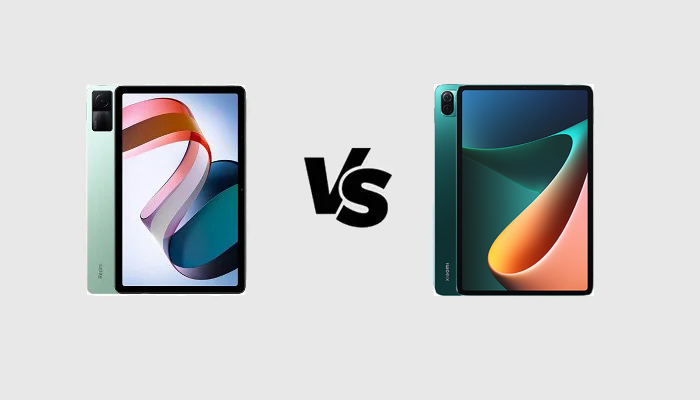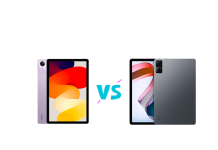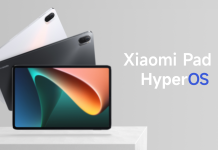Xiaomi has been in the tablet market for years, but this year is special because its sub-brand Redmi released its first tablet ever: the Redmi Pad. As you probably expected, it is an affordable tablet, but it provides high performance and a pretty good specs sheet. Xiaomi released a tablet in a similar price range the last year, and now, it is available at very interesting street prices. We are talking about the Xiaomi Pad 5. A lot of people are asking whether they should go for the new Redmi tablet because of its value for money or the older Xiaomi one from last year due to its interesting street prices. We will try to let you find out through this comparison between the specifications of the Redmi Pad and the Xiaomi Pad 5.

Xiaomi Redmi Pad vs Xiaomi Pad 5
| Xiaomi Redmi Pad | Xiaomi Pad 5 | |
|---|---|---|
| DIMENSIONS AND WEIGHT | 250.5 x 158.1 x 7.1 mm, 465 grams | 254.7 x 166.3 x 6.9 mm, 511 g |
| DISPLAY | 10.61 inches, 1200 x 2000p (Full HD+), IPS LCD | 11 inches, 1600 x 2560p (Quad HD+), IPS LCD |
| PROCESSOR | MediaTek Helio G99, octa-core 2.2 GHz | Qualcomm Snapdragon 860, octa-core 2.96 GHz |
| MEMORY | 3 GB RAM, 64 GB – 4 GB RAM, 128 GB – 6 GB RAM, 128 GB – micro SD slot | 6 GB RAM, 128 GB – 6 GB RAM, 256 GB |
| SOFTWARE | Android 12, MIUI | Android 11, MIUI |
| CONNECTIVITY | Wi-Fi 802.11 a/b/g/n/ac, Bluetooth 5.2, GPS | Wi-Fi 802.11 a/b/g/n/ac, Bluetooth 5.0, GPS |
| CAMERA | Single 8 MP f/2.0 8 MP f/2.3 front camera |
Single 13 MP f/2.0 8 MP f/2.0 front camera |
| BATTERY | 8000 mAh, fast charging 18W | 8720 mAh, fast charging 33W |
| ADDITIONAL FEATURES | Ultrawide front camera | Stylus support |
Design
If you are looking for one of the most beautiful tablets, then your choice in this comparison is the Xiaomi Pad 5. It has a good build quality including an aluminum frame and it comes with a higher screen to body ratio, so the bezels around the display are narrower. The tablet is very thin: the thickness is just 6.9 mm, and it is not so heavy as it weighs just 511 grams. The camera module is not so invasive and it takes just a small portion on the upper left corner of the rear cover. The Redmi Pad has thicker bezels around the display, as well as a bigger camera module, but you should note that it is more compact than its internal rival because it has a smaller display. It is also lighter with a weight of just 465 grams.
Display
Unfortunately, affordable tablets do not provide the best displays out there and they are far from the quality provided by the phones. But these two devices still come with good panels on the front side. The best display of the duo belongs to the Xiaomi Pad 5. It is an IPS LCD panel with a diagonal of 11 inches, a Quad HD+ resolution of 1600 x 2560 pixels, a 120 Hz refresh rate, HDR10 certification, and Dolby Vision. This display does not show the brilliant colors and the deep blacks provided by OLED panels, but it is able to show up to one billion colors. The Redmi Pad still comes with an IPS panel, but with a smaller 10.61-inch diagonal. It has a Full HD+ resolution of 1200 x 2000 pixels, a 90 Hz refresh rate, and it is able to show up to one billion colors. It is an inferior panel due to its lower resolution and refresh rate, and it does not have advanced video certifications. Both tablets feature four stereo speakers.
Specs & Software
The most powerful hardware belongs to the Xiaomi Pad 5. It is fueled by the Snapdragon 860 mobile platform by Qualcomm built with a 7 nm production process and sporting an octa-core architecture. The chipset is composed of a Kryo 485 Gold CPU running at a maximum frequency of 2.96 GHz, three Kryo 485 Gold CPUs with a 2.42 GHz frequency, four Kryo 485 Silver cores running at 1.78 GHz, and an Adreno 640 GPU. It is a high-end chipset paired with 6 GB of RAM and up to 256 GB of native storage (UFS 3.1). The Redmi Pad is powered by a MediaTek Helio G99 chipset running at 2.2 GHz and supported by up to 6 GB of RAM and up to 128 GB of native storage (UFS 2.2). The Xiaomi is more powerful, but it runs Android 11 out of the box, while the Redmi Pad ships with Android 12.
Camera
Another important advantage of the Xiaomi Pad 5 is the presence of a better main camera. On the rear side, this tablet sports a 13 MP shooter: nothing compared to the phones, but a pretty good sensor for tablets, able to record videos with a 4K resolution. The Redmi Pad has an 8 MP rear camera.
Battery
Last but not least, the Xiaomi Pad 5 has a bigger battery, with a capacity of 8720 mAh. It also charges quicker thanks to 33W fast charging. The Redmi Pad has a smaller 8000 mAh battery with 18W charging.
Price
The starting price of the Redmi Pad roughly translates into €250/$250, while you need €350/$350 to purchase the Xiaomi Pad 5. Which one would you pick?
Xiaomi Redmi Pad vs Xiaomi Pad 5: PRO and CONS
Xiaomi Redmi Pad
PRO
- More affordable
- More compact
- Android 12 out of the box
- Micro SD slot
CONS
- Limited availability
- Inferior hardware
Xiaomi Pad 5
PRO
- Better chipset
- Superior display
- Better camera
- Bigger battery
- Beautiful design
- Stylus support
- Wider availability
CONS
- Price
RELATED







